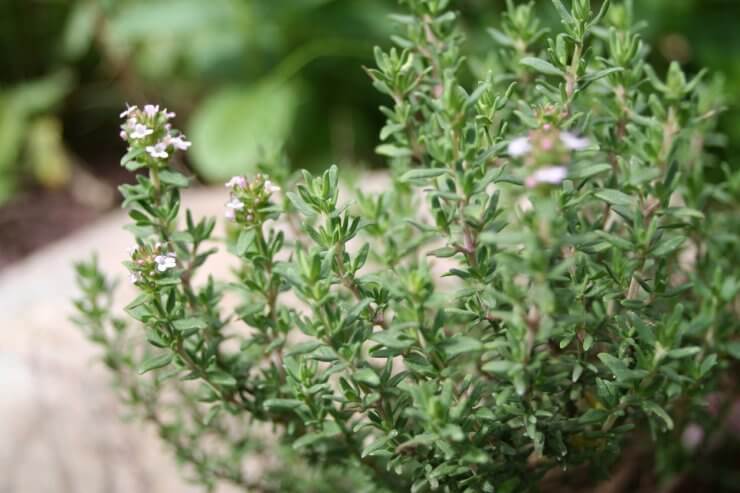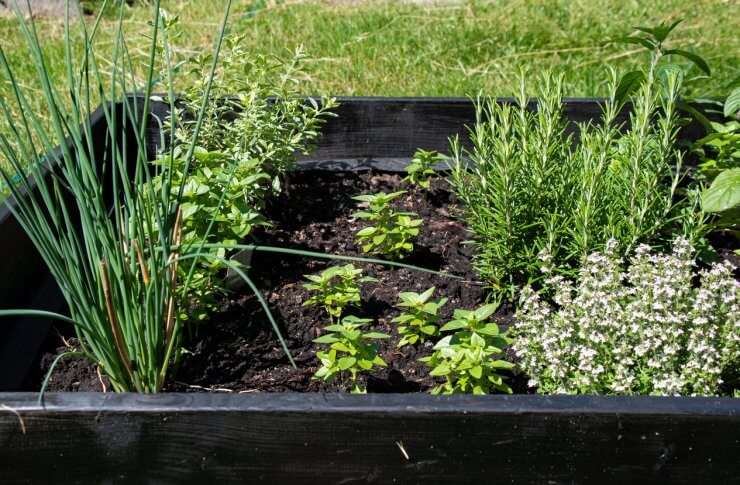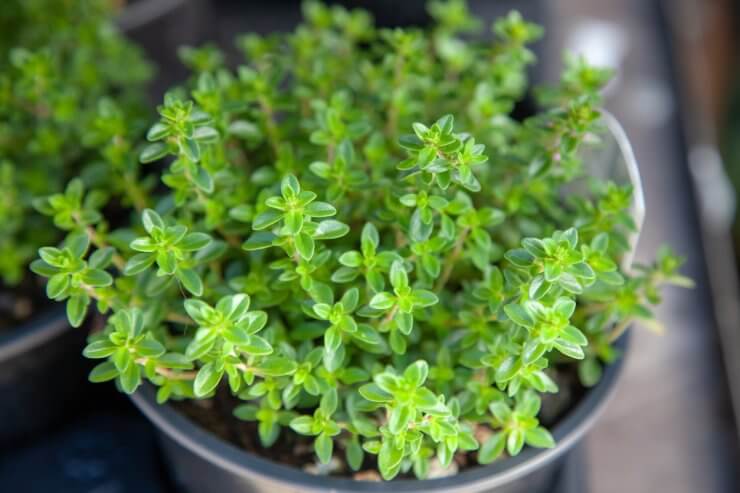
Thyme in an open land garden
Thyme plants are easy to plant and grow, but they have a few requirements that can affect where you plant them. Most thyme varieties prefer full sun, though some can tolerate some shade, and they hate wet feet, so they require sandy or loamy soil that drains well. Prostrate thyme plants, especially those that creep, will need room to spread.
If you have a large outside plot of land with the right soil and the right conditions for watering and draining, you might have the ideal situation for planting your thyme. If, however, your soil has too much clay or gets soggy, you might want to consider planting in raised beds or in containers.
Growing in Raised Beds

Thyme and other herbs growing in a raised bed
Raised beds are a great option for growing thyme if you have perpetually wet, heavy soil. Creating raised beds for your thyme garden can be a lot of work the first time you set up your beds, but having raised beds allows you more control over your growing environment. You’ll discover that watering, irrigation, weeding, and even harvesting are much easier, with items closer to your reach and contained in a space that is more manageable than growing in open land.
To create nicely contained raised beds for your thyme, enclose your raised beds with wooden sides 8 to 10 inches deep. Plant your thyme in the middle of the raised bed, not along the edges—this will help insulate the plants’ root in winter.
A raised bed garden is less likely to contain the seeds of weeds that are often found in garden soil. You’ll minimize the incidence of weeds overall, which will save you time and effort later. Weeding itself is much easier with raised beds, because you don’t have to get down so far on the ground to remove weeds.
Raised Bed Planting Tip: Be sure to amend your soil with compost at least once a year. Otherwise, your soil can become less productive for your plants.
Growing Thyme in Containers or Pots

Thyme growing in a pot
Thyme makes an excellent container plant, whether you choose an upright variety to plant in a pot on the patio or a slow-growing creeper to spill over the edge of a window box. Growing thyme in a container inside your home also makes it easy to enjoy fresh thyme year-round, whether or not you have land for a garden.
One great advantage to container gardening is the ability to move plants around more easily to maximize their exposure to the sun. Thyme grows best when it has at least six hours of sun, and it can tolerate indirect sunlight. A southern or western exposure is ideal for growing thyme indoors.
Thyme prefers dry conditions, so a clay pot with a drainage hole makes the best thyme container; it will allow the plant to dry out between watering. A mix of sand, potting soil, perlite, and peat moss will provide the right drainage and nutrient environment for your thyme plants.
Though weeding is much easier with containers, you have to be more vigilant about watering and irrigation as plants can dry out much faster than when they’re in the ground. However, with thyme, overwatering is a bigger problem because it can cause root rot. Water your thyme plants thoroughly, but allow the soil to dry out before watering again. Thyme originated in the hot, dry Mediterranean region, so it can handle dry conditions far better than wet.
Whether growing thyme in containers inside or out, be sure to cut back woody stems to encourage new growth. Removing flowers promotes leaf growth, too. But don’t throw the buds away! Toss them into salads or dry them for sachets or tea.
Your container-grown thyme should be repotted every year or two. It’s easy to do this by dividing the plant and repotting the divisions or simply graduating to a larger pot. Indoor thyme plants will benefit from some fresh air, so take them outside in the summer, starting with a few hours in a sheltered area each day until they become acclimated.
How do you grow your thyme—in open land, in raised beds, or in containers? Why do you prefer your method? Please tell us your tips and tricks for creating a bountiful thyme garden.


 Previous
Previous

